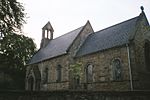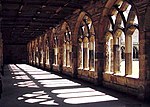St Cuthbert's Society, Durham

St Cuthbert's Society, colloquially known as Cuth's, is a college of Durham University. It was founded in 1888 for students who were not attached to the existing colleges. St Cuthbert's Society is a Bailey college, based on Durham's peninsula next to the River Wear, although it also has other accommodation a few minutes' walk away in Old Elvet. St Cuthbert's retains its title of 'society', although its workings have changed since its formation. Its foundation differed from that of Durham's other colleges in that it was established as a common room for, and by, its students. Other Societies followed: St Aidan's Society – now St Aidan's College, and the Graduate Society – now Ustinov College. It is still home to the highest proportion of local students (very few of whom live in) and traditionally houses a high proportion of mature students. It is the only collegiate body to offer undergraduates catered, self-catered, and part catered accommodation.
Excerpt from the Wikipedia article St Cuthbert's Society, Durham (License: CC BY-SA 3.0, Authors, Images).St Cuthbert's Society, Durham
Principal's Walk, Durham Viaduct
Geographical coordinates (GPS) Address External links Nearby Places Show on map
Geographical coordinates (GPS)
| Latitude | Longitude |
|---|---|
| N 54.770833333333 ° | E -1.5772222222222 ° |
Address
St Cuthbert's Society
Principal's Walk
DH1 3EE Durham, Viaduct
England, United Kingdom
Open on Google Maps










